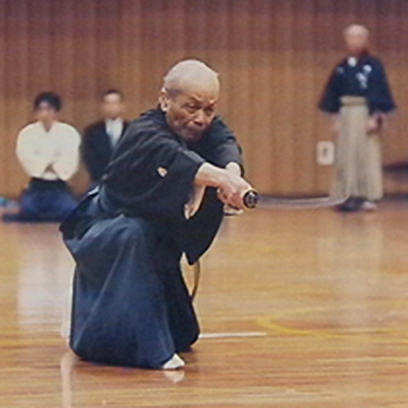21 : CONCERNING THE OBI AND SAGEO OF THE BUSHI August 1936
According to the old writings, the Bushi used to wear a Kaku-Obi (a stiff wide sash similar to an Iaido Obi) customarily worn under the Hakama. Daisho were worn in the following manner;
a, The Shoto was worn between the body and the sash, the Tsuba centering in front of the body.
b, The Daito was worn inside one layer of the Obi, The Tsuka-gashira centring in front of the body. Tying the Sageo is too complicated to explain in writing, especially the Shoto. It would be advisable to ask your Sensei, a senior or friend to show you in detail. However, tying the Sageo practically for the battlefield was entirely different to formal methods. Soldiers used to tie their Sageo very firmly regardless of style.
Addition : As above when Daisho were worn, the Tsuka-gashira of the Daito was on the centre line of the body. As nowadays as only the Daito is worn in Iaido, the Tsuba instead of the Tsuka-gashira is centred. Among the students of Oe Sensei there were a few people who used to finish Noto by centring the Tsuka-gashira. I saw Master Fukui Haramasa do this. He pushed the Tsuka to the left with his right hand, bringing the Tsuka to the centre before releasing it. He did this without hesitation.
22 : KEN WA KOKORO NARI (The Sword is the Heart) 1st January 1937
The ancient Masters said The sword is the heart if the heart is right. If the heart is wrong, then the sword is wrong. Indeed the sword is an expression of ones own heart. The way of the sword is to improve ones own heart without using the sword. High, low, strong, weak, fast, slow etc. with concern to cutting technique is a very trivial facet.
The importance of mentality and spirituality must be studied ultimately to achieve the real Way of the sword.
The Nihonto possessing the spirit of God is not a weapon to cut people with. To use the sword as Katsujin Ken is the correct way. Therefore a student who really wants to learn the way of the sword should not need to get too exasperated about physical movements or techniques.
Addition : Sword is the heart, teaches us to handle and respect the sword as a part of our own body. I have watched a high ranking Kendo teacher wiping his Shinai with a Tenegui after practice. Seeing this I was very surprised and felt that I should perhaps treat my own sword more carefully. The price or quality of a sword is insignificant. The person who holds the sword is foremost. Posturing or just standing holding a sword is also of no consequence. It could mean that this person cares very much for the sword or is perhaps unconcerned.
23: LIFETIMES WORK AND BUDO - 1st January 1938
Any art called Do (The way of) seems to be different in appearance. Sado (Tea), Kado (Flower), Shodo (Calligraphy), Kendo, Judo, Aikido, Karate-Do etc. The physical activity is different in each Do. But the objective is the same. They are all aiming for the Perfection of the human being, by training in their own kind of art.
Kono Hyakuren Sensei is simply saying that ones lifetimes work (profession) and Budo should go together in life.
I hope readers can concur with this.

Note from the Translator:
I hope that followers of Muso Jikiden Eishin Ryu will find this of interest.
© 1994 Colin Hyakutake-Watkin.
10th Menkyo Kaiden Taiko-Konoha-Ryu.
Hyoho Niten Ichiryu Menkyo
Kageryu Shihan
| Home |